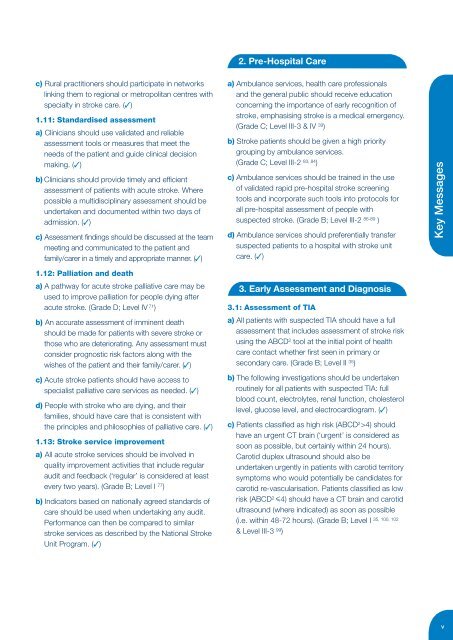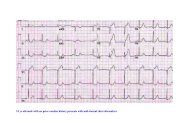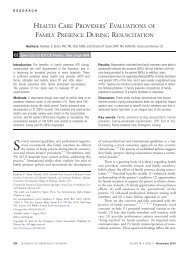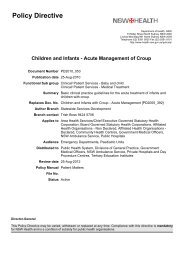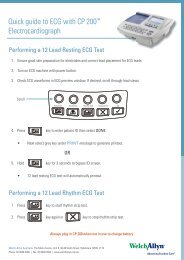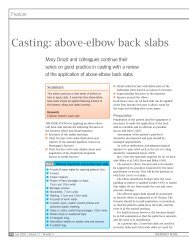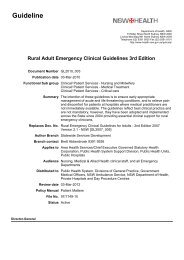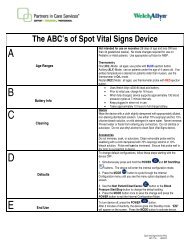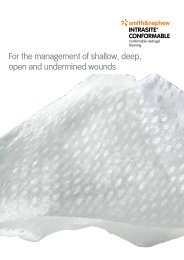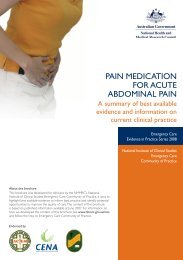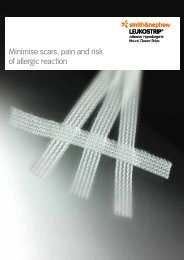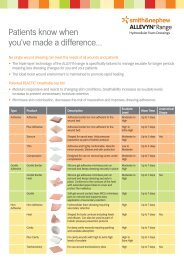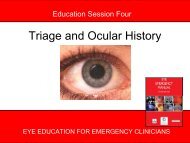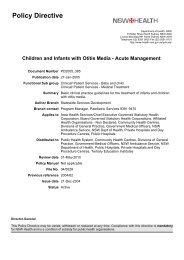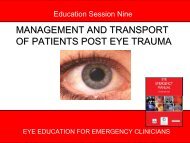Clinical Guidelines for Acute Stroke Management - Living on the EDge
Clinical Guidelines for Acute Stroke Management - Living on the EDge
Clinical Guidelines for Acute Stroke Management - Living on the EDge
You also want an ePaper? Increase the reach of your titles
YUMPU automatically turns print PDFs into web optimized ePapers that Google loves.
2. Pre-Hospital Care<br />
c) Rural practiti<strong>on</strong>ers should participate in networks<br />
linking <strong>the</strong>m to regi<strong>on</strong>al or metropolitan centres with<br />
specialty in stroke care. ( )<br />
1.11: Standardised assessment<br />
a) Clinicians should use validated and reliable<br />
assessment tools or measures that meet <strong>the</strong><br />
needs of <strong>the</strong> patient and guide clinical decisi<strong>on</strong><br />
making. ( )<br />
b) Clinicians should provide timely and efficient<br />
assessment of patients with acute stroke. Where<br />
possible a multidisciplinary assessment should be<br />
undertaken and documented within two days of<br />
admissi<strong>on</strong>. ( )<br />
c) Assessment findings should be discussed at <strong>the</strong> team<br />
meeting and communicated to <strong>the</strong> patient and<br />
family/carer in a timely and appropriate manner. ( )<br />
1.12: Palliati<strong>on</strong> and death<br />
a) A pathway <str<strong>on</strong>g>for</str<strong>on</strong>g> acute stroke palliative care may be<br />
used to improve palliati<strong>on</strong> <str<strong>on</strong>g>for</str<strong>on</strong>g> people dying after<br />
acute stroke. (Grade D; Level IV 71 )<br />
b) An accurate assessment of imminent death<br />
should be made <str<strong>on</strong>g>for</str<strong>on</strong>g> patients with severe stroke or<br />
those who are deteriorating. Any assessment must<br />
c<strong>on</strong>sider prognostic risk factors al<strong>on</strong>g with <strong>the</strong><br />
wishes of <strong>the</strong> patient and <strong>the</strong>ir family/carer. ( )<br />
c) <str<strong>on</strong>g>Acute</str<strong>on</strong>g> stroke patients should have access to<br />
specialist palliative care services as needed. ( )<br />
d) People with stroke who are dying, and <strong>the</strong>ir<br />
families, should have care that is c<strong>on</strong>sistent with<br />
<strong>the</strong> principles and philosophies of palliative care. ( )<br />
1.13: <str<strong>on</strong>g>Stroke</str<strong>on</strong>g> service improvement<br />
a) All acute stroke services should be involved in<br />
quality improvement activities that include regular<br />
audit and feedback (‘regular’ is c<strong>on</strong>sidered at least<br />
every two years). (Grade B; Level I 77 )<br />
b) Indicators based <strong>on</strong> nati<strong>on</strong>ally agreed standards of<br />
care should be used when undertaking any audit.<br />
Per<str<strong>on</strong>g>for</str<strong>on</strong>g>mance can <strong>the</strong>n be compared to similar<br />
stroke services as described by <strong>the</strong> Nati<strong>on</strong>al <str<strong>on</strong>g>Stroke</str<strong>on</strong>g><br />
Unit Program. ( )<br />
a) Ambulance services, health care professi<strong>on</strong>als<br />
and <strong>the</strong> general public should receive educati<strong>on</strong><br />
c<strong>on</strong>cerning <strong>the</strong> importance of early recogniti<strong>on</strong> of<br />
stroke, emphasising stroke is a medical emergency.<br />
(Grade C; Level III-3 & IV 39 )<br />
b) <str<strong>on</strong>g>Stroke</str<strong>on</strong>g> patients should be given a high priority<br />
grouping by ambulance services.<br />
(Grade C; Level III-2 83, 84 )<br />
c) Ambulance services should be trained in <strong>the</strong> use<br />
of validated rapid pre-hospital stroke screening<br />
tools and incorporate such tools into protocols <str<strong>on</strong>g>for</str<strong>on</strong>g><br />
all pre-hospital assessment of people with<br />
suspected stroke. (Grade B; Level III-2 86-89 )<br />
d) Ambulance services should preferentially transfer<br />
suspected patients to a hospital with stroke unit<br />
care. ( )<br />
3. Early Assessment and Diagnosis<br />
3.1: Assessment of TIA<br />
a) All patients with suspected TIA should have a full<br />
assessment that includes assessment of stroke risk<br />
using <strong>the</strong> ABCD 2 tool at <strong>the</strong> initial point of health<br />
care c<strong>on</strong>tact whe<strong>the</strong>r first seen in primary or<br />
sec<strong>on</strong>dary care. (Grade B; Level II 35 )<br />
b) The following investigati<strong>on</strong>s should be undertaken<br />
routinely <str<strong>on</strong>g>for</str<strong>on</strong>g> all patients with suspected TIA: full<br />
blood count, electrolytes, renal functi<strong>on</strong>, cholesterol<br />
level, glucose level, and electrocardiogram. ( )<br />
c) Patients classified as high risk (ABCD 2 >4) should<br />
have an urgent CT brain (‘urgent’ is c<strong>on</strong>sidered as<br />
so<strong>on</strong> as possible, but certainly within 24 hours).<br />
Carotid duplex ultrasound should also be<br />
undertaken urgently in patients with carotid territory<br />
symptoms who would potentially be candidates <str<strong>on</strong>g>for</str<strong>on</strong>g><br />
carotid re-vascularisati<strong>on</strong>. Patients classified as low<br />
risk (ABCD 2 4) should have a CT brain and carotid<br />
ultrasound (where indicated) as so<strong>on</strong> as possible<br />
(i.e. within 48-72 hours). (Grade B; Level I<br />
35, 100, 102<br />
& Level III-3 99 )<br />
vs<br />
Key Message


